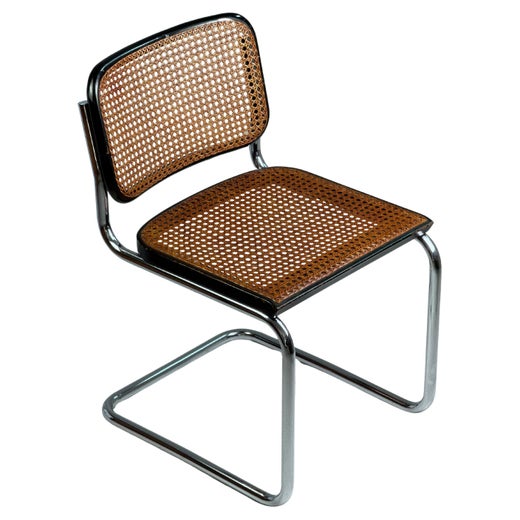"Bryn Mawr" Chairs by Marcel Breuer
About the Item
These replicas are made for us by a small workshop in Los Angeles. They precisely duplicate the rare 1938 originals, except for the seating surfaces, which (instead of the solid blocks of wood used on the vintage versions) are made of dowels arranged in parallel. This was evidently the way Breuer first envisioned the chair, switching to conventional solid wood as an economizing measure.
Each chair is priced at $1400.
- Creator:Marcel Breuer (Designer)
- Dimensions:Height: 33 in (83.82 cm)Width: 19 in (48.26 cm)Depth: 19 in (48.26 cm)
- Sold As:Set of 16
- Period:
- Date of Manufacture:designed 1938
- Condition:Excellent condition.
- Seller Location:Los Angeles, CA
- Reference Number:1stDibs: U1110188091606
Marcel Breuer
The architect and designer Marcel Breuer was one the 20th century’s most influential and innovative adherents of modernism. A member of the Bauhaus faculty, Breuer — like such colleagues as the architects Walter Gropius and Ludwig Mies van der Rohe, and the artists and art theoreticians László Moholy-Nagy and Josef Albers — left Europe in the 1930s to champion the new design philosophy and its practice in the United States.
Born in Hungary, Breuer became a Bauhaus student in 1920 and quickly impressed Gropius, the German school’s founder, with his aptitude for furniture design. His early work was influenced by the minimalist Dutch design movement De Stijl — in particular the work of architect Gerrit Rietveld.
In 1925, while he was head of the Bauhaus furniture workshop, Breuer realized his signature innovation: the use of lightweight tubular-steel frames for chairs, tables and sofas — a technique soon adopted by Mies and others. Breuer’s attention gradually shifted from design to architecture, and, at the urging of Gropius, he joined his mentor in 1937 on the faculty of Harvard and in an architectural practice.
In the 1940s, Breuer opened his own architectural office, and there his style evolved from geometric, glass-walled structures toward a kind of hybrid architecture — seen in numerous Breuer houses in New England — that pairs bases of local fieldstone with sleek, wood-framed modernist upper floors. In his later, larger commissions, Breuer worked chiefly with reinforced concrete and stone, as seen in his best-known design, the brutalist inverted ziggurat built in New York in 1966 as the home of the Whitney Museum of American Art.
Breuer’s most famous furniture pieces are those made of tubular steel, which include the Wassily chair — named after Wassily Kandinsky and recognizable for its leather-strap seating supports — and the caned Cesca chair.
Breuer also made several notable designs in molded plywood, including a chaise and nesting table for the British firm Isokon and a student furniture suite commissioned in 1938 for a dormitory at Bryn Mawr College. Whether in metal or wood, Breuer’s design objects are elegant and adaptable examples of classic modernist design — useful and appropriate in any environment.
Find vintage Marcel Breuer seating, storage cabinets and lighting on 1stDibs.
You May Also Like
Vintage 1920s Italian Bauhaus Dining Room Chairs
Stainless Steel, Chrome
Vintage 1960s European Bauhaus Dining Room Chairs
Metal
Vintage 1980s North American Mid-Century Modern Armchairs
Chrome
Vintage 1950s Italian Mid-Century Modern Chairs
Steel
Vintage 1920s Italian Bauhaus Dining Room Chairs
Chrome
Mid-20th Century Italian Mid-Century Modern Side Chairs
Chrome
Vintage 1980s German Bauhaus Dining Room Chairs
Steel
Vintage 1950s Side Chairs
Rattan
Vintage 1930s German Bauhaus Dining Room Chairs
Stainless Steel
Vintage 1980s Italian Mid-Century Modern Chairs
Metal
